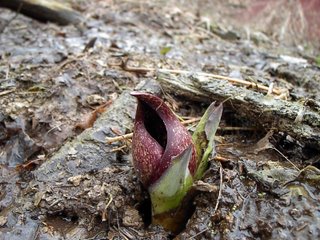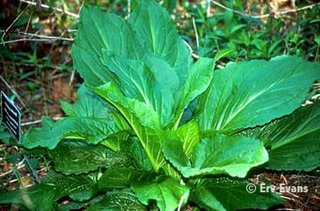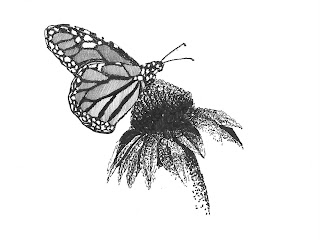Symplocarpus foetidus
Not so Virtual Homestead posted pictures of skunk cabbage coming up on her property. I envy those that have streams or wetlands on their land. The addition of hydric soils and wetland hydrology opens up an entirely new world of plants that simply will not grow elsewhere. One of my favorites is the Skunk Cabbage. Forget Hellebores and snowdrops....Skunk Cabbage steps on-stage in early to mid-February. This positively prehistoric plant actually makes it's own heat through a chemical reaction to thrust it's spathe up through the earth,  heating to as much as 36 degrees F above ambient air temperature to melt a snow cover. The red-mottled spathe conceals the seed head or spadix tucked inside. You would think Symplocarpus would have a hard time finding a pollinator, given that it's still pretty cold out when the time is right. The combination of the heat of Skunk Cabbage and the putrid smell it gives off draw....what else? Flies. A lot of reference books say that
heating to as much as 36 degrees F above ambient air temperature to melt a snow cover. The red-mottled spathe conceals the seed head or spadix tucked inside. You would think Symplocarpus would have a hard time finding a pollinator, given that it's still pretty cold out when the time is right. The combination of the heat of Skunk Cabbage and the putrid smell it gives off draw....what else? Flies. A lot of reference books say that Symplocarpus smells like rotting meat. I've never smelled that. It smells like Skunk. Many times, out doing a wetland delineation, I've stepped on the very tip of the spathe emerging from the ground without knowing it and spent a good five or ten minutes looking for the skunk that surely must by lurking about. The skunk cabbage has the largest leaves of any North American herbaceous plant, unfurling up to a startling 5 feet in length. All those leaves unfold from the two small buds that
Symplocarpus smells like rotting meat. I've never smelled that. It smells like Skunk. Many times, out doing a wetland delineation, I've stepped on the very tip of the spathe emerging from the ground without knowing it and spent a good five or ten minutes looking for the skunk that surely must by lurking about. The skunk cabbage has the largest leaves of any North American herbaceous plant, unfurling up to a startling 5 feet in length. All those leaves unfold from the two small buds that  emerge with the spathe. I would love to have a time lapse video showing that happening. Symplocarpus is an obligate plant. What does that mean? The United States Fish and Wildlife Service publishes a list called the National List of Vascular Plant Species that Occur in Wetlands. It gives an indicator status to almost every plant known in the continental United States. The indicator status suggests where that plant likes to live. Obligate suggests that 99% of the time, that plant will be found in a wetland. The opposite of obligate is Upland, meaning 99% of the time, that plant will be found in dry conditions. Field Thistle is an example of an Upland Plant. Then there are three designations in between, indicating varying percentages of occurrence in a wetland as opposed to an upland. Anyway, skunk cabbage really, really likes wet feet. I'm not sure that you are able to buy Skunk cabbage, in case you wanted to add it your wet area. I've never seen it. And as they have a suprisingly extensive root system, they are almost impossible to successfully transplant. So if you have Symplocarpus, consider yourself lucky. I'll just have to enjoy it when I come across it.
emerge with the spathe. I would love to have a time lapse video showing that happening. Symplocarpus is an obligate plant. What does that mean? The United States Fish and Wildlife Service publishes a list called the National List of Vascular Plant Species that Occur in Wetlands. It gives an indicator status to almost every plant known in the continental United States. The indicator status suggests where that plant likes to live. Obligate suggests that 99% of the time, that plant will be found in a wetland. The opposite of obligate is Upland, meaning 99% of the time, that plant will be found in dry conditions. Field Thistle is an example of an Upland Plant. Then there are three designations in between, indicating varying percentages of occurrence in a wetland as opposed to an upland. Anyway, skunk cabbage really, really likes wet feet. I'm not sure that you are able to buy Skunk cabbage, in case you wanted to add it your wet area. I've never seen it. And as they have a suprisingly extensive root system, they are almost impossible to successfully transplant. So if you have Symplocarpus, consider yourself lucky. I'll just have to enjoy it when I come across it.
 heating to as much as 36 degrees F above ambient air temperature to melt a snow cover. The red-mottled spathe conceals the seed head or spadix tucked inside. You would think Symplocarpus would have a hard time finding a pollinator, given that it's still pretty cold out when the time is right. The combination of the heat of Skunk Cabbage and the putrid smell it gives off draw....what else? Flies. A lot of reference books say that
heating to as much as 36 degrees F above ambient air temperature to melt a snow cover. The red-mottled spathe conceals the seed head or spadix tucked inside. You would think Symplocarpus would have a hard time finding a pollinator, given that it's still pretty cold out when the time is right. The combination of the heat of Skunk Cabbage and the putrid smell it gives off draw....what else? Flies. A lot of reference books say that Symplocarpus smells like rotting meat. I've never smelled that. It smells like Skunk. Many times, out doing a wetland delineation, I've stepped on the very tip of the spathe emerging from the ground without knowing it and spent a good five or ten minutes looking for the skunk that surely must by lurking about. The skunk cabbage has the largest leaves of any North American herbaceous plant, unfurling up to a startling 5 feet in length. All those leaves unfold from the two small buds that
Symplocarpus smells like rotting meat. I've never smelled that. It smells like Skunk. Many times, out doing a wetland delineation, I've stepped on the very tip of the spathe emerging from the ground without knowing it and spent a good five or ten minutes looking for the skunk that surely must by lurking about. The skunk cabbage has the largest leaves of any North American herbaceous plant, unfurling up to a startling 5 feet in length. All those leaves unfold from the two small buds that  emerge with the spathe. I would love to have a time lapse video showing that happening. Symplocarpus is an obligate plant. What does that mean? The United States Fish and Wildlife Service publishes a list called the National List of Vascular Plant Species that Occur in Wetlands. It gives an indicator status to almost every plant known in the continental United States. The indicator status suggests where that plant likes to live. Obligate suggests that 99% of the time, that plant will be found in a wetland. The opposite of obligate is Upland, meaning 99% of the time, that plant will be found in dry conditions. Field Thistle is an example of an Upland Plant. Then there are three designations in between, indicating varying percentages of occurrence in a wetland as opposed to an upland. Anyway, skunk cabbage really, really likes wet feet. I'm not sure that you are able to buy Skunk cabbage, in case you wanted to add it your wet area. I've never seen it. And as they have a suprisingly extensive root system, they are almost impossible to successfully transplant. So if you have Symplocarpus, consider yourself lucky. I'll just have to enjoy it when I come across it.
emerge with the spathe. I would love to have a time lapse video showing that happening. Symplocarpus is an obligate plant. What does that mean? The United States Fish and Wildlife Service publishes a list called the National List of Vascular Plant Species that Occur in Wetlands. It gives an indicator status to almost every plant known in the continental United States. The indicator status suggests where that plant likes to live. Obligate suggests that 99% of the time, that plant will be found in a wetland. The opposite of obligate is Upland, meaning 99% of the time, that plant will be found in dry conditions. Field Thistle is an example of an Upland Plant. Then there are three designations in between, indicating varying percentages of occurrence in a wetland as opposed to an upland. Anyway, skunk cabbage really, really likes wet feet. I'm not sure that you are able to buy Skunk cabbage, in case you wanted to add it your wet area. I've never seen it. And as they have a suprisingly extensive root system, they are almost impossible to successfully transplant. So if you have Symplocarpus, consider yourself lucky. I'll just have to enjoy it when I come across it.


10 Comments:
I absolutely love this information! I have some, but not enough, skunk cabbage growing in the wetlands of our property--sitting in water. It isn't showing itself yet & I wait patiently. It is one of my favorite plants of the wet area on our property. I found a place that sold the plant, but only to Landscapers, Whatever, not to those Humble Gardeners who worship it. It smells like skunk to me too.....thanks Meredith!
Why would a landscaper need Skunk Cabbage? Weird. YOu are lucky to have wetlands on your property. They spread by seed, so when the seed head is ripe in late summer, try planting some and see what happens.
I've never seen this except at the Bot. Gdns. Thanks for the foliage pic - nobody ever shows that! :)
I think the range only extends to maybe Virginia or North Carolina. I'm sure you have all kinds of cool wetland plants as far south as you are, Rurality.
We have skunk cabbage in Western Washington State....Thanks for the information about transplanting. Carolyn
Yuck! This stuff grows in the bog below my property, and is trying to invade my garden. Out, out, damn skunk cabbage! If you really did have this on your property you wouldn't want it!
We used to have skunk cabbage on our property in Southern Connecticut.
Hallo, I´m a gardener from Czech republic,i would like to plant Symplocarpus foetidus where is it possible to buy? Thank you for answer J.Rehor - azaro@azaro.cz
This blog is really helpful to me, Lots of idea I got from this site.
unfortunatelly these plants are relativelly small. with the story behind them they could be a lot more popular in people's households
Post a Comment
<< Home